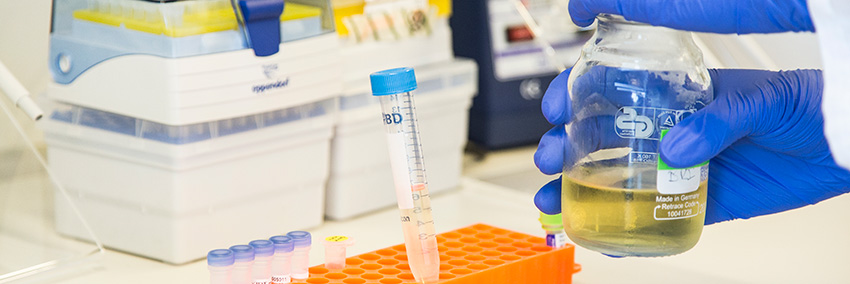
The Junior Research Group Program (JRGP) has been an integral part of the Center's support measures for junior researchers’ careers. The CMMC offers junior scientists with exceptional credentials an excellent opportunity to further their academic career.
The Center provides funding for up to three internationally competitive JRG leaders. The selection process for appointing scientists as JRG leaders has been initiated. The groups not only have access to the CMMC´s infrastructure and administration, but are also provided with considerable funds for personnel, equipment and running costs, as well as negotiable additional funds that enable the group leaders to further strenghten their research project. The support of the JRGs is comparable to the Emmy Noether-Programm by the DFG and equivalent to a non-tenured Assistant Professorship with a running period of 5 (+3) years (previous CMMC JRG Groups).
In 2019 the CMMC awarded three open positions as CMMC JRG leaders in the field of Molecular Medicine. The CMMC also supports Junior Research Groups working in the field of Molecular Medicine that are funded by external institutions as "associated JRGs" by providing access to lab/research space and the Center’s infrastructure.
These associated JRGs benefit from the CMMC´s dynamic allocation concept of lab/research in the CMMC Research Building. Currently the CMMC supports the six associated Junior Research Groups.

We are focussed on the role of cell death in health and disease. In particular, we investigate the molecular mechanisms regulating different forms of cell death (e.g. apoptosis and necroptosis) and how cell death contributes to inflammatory programs, activated following pathogenic infection or tissue damage, as well as to tumorigenesis. Understanding the complex relationship between cell death and inflammation will help to improve the current treatments of chronic inflammatory diseases and cancer.

The Computational Biology Aging group aims to apply state-of-the-art computational approaches to address challenges in ageing, stress (including disease), and regulatory acceptance.Central to our approach is the integration of multiple levels of data to better understand the specific biological system. Here we are able to make use of available complex datasets, including OMICs, chemistry, or other metadata to, for example, develop novel multivariate biomarkers or develop new adverse outcome pathways.

Our lab explores the existence and significance of epigenome structural alterations for ageing and its impact on disease development.Hence, the structure of the genome may significantly change with age and become predisposed to disease development, such as cancer or degenerative diseases.In particular, we are elucidating whether epigenome structural alterations, such as four-stranded G-quadruplex (G4) DNA, promote age-related genome instability and rewire gene activity and regulation.

Dr. Maleki's group focuses on the rational design of self-assembled and sol-gel derived bio-inspired hybrid smart nanomaterials as a theragenerative systems (combination of therapy and regeneration) with improved biomimetic microstructure, mechanical, self-healing and shape morphing properties for minimally invasive bone cancer therapy and bone regeneration and drug delivery purposes.
In our research we are specifically interested in designing biomaterials (hydrogels, and aerogels) with smart multifunctional properties through hybridization of self-assembled biopolymer with various surface engineered nanoparticles through the most advanced state-of-the-art synthesis and fabrication techniques like 3D printing and microfluidic systems.
With this advanced synthetic biomaterials, we would like to understand how the biomaterials-cell interactions can be regulated in order to enhance the cells osteoconductivity, osteoinductivity while also endowing anti-tumoral or anti-bacterial functionalities.

Cell death and inflammation are common features of many autoimmune and degenerative disorders. It is now clear that cell death can trigger chronic inflammation resulting in autoimmunity and degenerative diseases, including cancer. Therefore, understanding the crosstalk between death and inflammation is important to find effective therapies for such diseases. We aim to investigate the processes regulating the execution of cell death downstream of innate immune receptors. In particular, we want to uncover the importance of different modalities of cell death in autoimmune diseases and cancer, with the ultimate purpose to find to therapeutic strategies to tackle inflammation-dependent pathologies.

We are interested in the mechanisms that regulate chemical modifications of histone proteins. As signals that orchestrate gene expression, cell differentiation and many other processes, these reactions have to be faithfully controlled. Our biochemical understanding of the multiprotein complexes that catalyze these reactions is still very limited. Therefore, we aim to define aspects of their context dependent, local activity regulation using cryo-electron microscopy (cryo-EM), biochemical and cell biological approaches.

The emergence of multidrug-resistant (MDR) bacteria is a major public health concern with increasing mortality throughout the world. While nowadays new drugs and therapeutic approaches are on the rise for many diseases, the clinical implementation of innovative therapeutics in the treatment of bacterial infections is stagnating. To overcome the limited amount of new antibiotics, the development of immunotherapies, which enhance the host immune response, seems reasonable. This approach might be particularly effective in immunocompromised patients such as critically ill patients or patients receiving chemotherapy. Accordingly, our group explores the host-pathogen interactions of clinically relevant bacteria to develop new powerful immunotherapeutic strategies in the fight against MDR bacteria.

Interactions between viruses and the immune system of an infected patient have a strong influence on both organisms. After infection, the human immune system aims to improve its ability to detect and combat the respective virus while the pathogen can develop escape mutations that allow him to evade these immune responses. If these mutations also do not alter the ‘viral fitness’ (its ability to replicate and infect more cells), this viral quasispecies will have an evolutionary advantage over the ancestral virus, will finally outnumber him and force the human immune system to adapt its response again.
With the overall aim to improve future antiviral therapies and vaccines, our group aims to
i) better understand these host-virus interactions,
ii) implement novel techniques to rapidly detect viral escape and
iii) develop strategies that hamper viral escape.

We are interested in understanding the mechanisms governing the homeostasis of the cellular proteome (proteostasis). Protein structures are highly complex and dynamic, and several stresses can compromise their integrity. Therefore, cells are equipped with an intricate and adaptive network of factors ensuring protein synthesis, folding, trafficking, conformational maintenance, and degradation. Importantly, misfolded proteins are not only dysfunctional, but they can also coalesce into potentially toxic aggregates. These represent a hallmark of many aging-associated neurodegenerative disorders, such as Parkinson’s and Alzheimer’s diseases. Our aims are to understand how protein quality control pathways distinguish defective from functional proteins, how the decision between repair and elimination is made, and how these processes are activated under stress and pathological conditions.